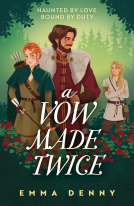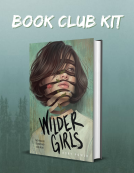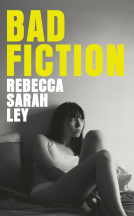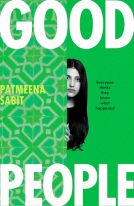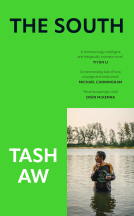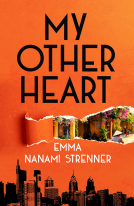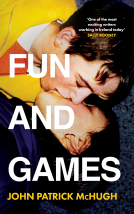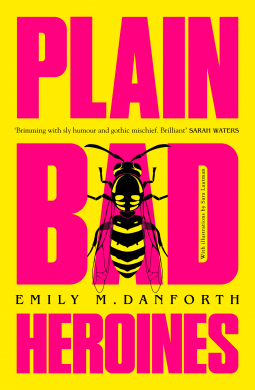
Plain Bad Heroines
by Emily M. Danforth
This title was previously available on NetGalley and is now archived.
Send NetGalley books directly to your Kindle or Kindle app
1
To read on a Kindle or Kindle app, please add kindle@netgalley.com as an approved email address to receive files in your Amazon account. Click here for step-by-step instructions.
2
Also find your Kindle email address within your Amazon account, and enter it here.
Pub Date 4 Feb 2021 | Archive Date 1 Apr 2022
HarperCollins UK, HarperFiction | The Borough Press
Talking about this book? Use #PlainBadHeroines #NetGalley. More hashtag tips!
Description
⚠️ WARNING: keep this book away from impressionable female readers⚠️
‘Brimming from start to finish with sly humour and gothic mischief, Plain Bad Heroines is a brilliant piece of exuberant storytelling by a terrifically talented author’ SARAH WATERS
🐝🐝🐝
1902, Brookhants School for Girls: students Flo and Clara are madly in love with each other, as well as completely obsessed with The Story of Mary MacLane, the scandalous debut memoir by 19 year old MacLane. A few months later they are found dead in the woods, after a horrific wasp, the book lying next to their intertwined bodies. Within five years The Brookhants School for Girls is closed. But not before three more people died on the property, each in a troubling way.
Over a hundred years later, Brookhants opens its doors once more, when a crew of young actresses arrive to film a high-profile movie about the rumoured Brookhants curse. And as past and present become grimly entangled, it’s soon impossible to tell quite where the curse leaves off and Hollywood begins…
🐝🐝🐝
For fans of Sarah Waters, Curtis Sittenfeld and Shirley Jackson, Plain Bad Heroines is by turns sharply witty and deeply unsettling: a modern gothic novel that is utterly immersive and hugely compelling.
Advance Praise
‘Brimming from start to finish with sly humour and gothic mischief, Plain Bad Heroines is a brilliant piece of exuberant storytelling by a terrifically talented author’ SARAH WATERS
‘Ingenious, jaw-dropping…Plain Bad Heroines is a queer roar and it's terrifying and it's a goddamned triumph’ Paul Tremblay, author of A Head Full of Ghosts and The Cabin at the End of the World
‘Plain Bad Heroines wears its brilliance lightly…it's dark, sweet, and addictive. Emily Danforth displays all the gothic wit of Edward Gorey and all the soaring metafictional ambitions of David Mitchell, alongside a generosity and humanity that is uniquely her own. Simply one of the best books I've read in the last decade’ Joe Hill, New York Times bestselling author of The Fireman
‘Full of Victorian sapphic romance, metafictional horror, biting misandrist humour, Hollywood intrigue, and multiple timeliness – all replete with evocative illustrations that are icing on a deviously delicious cake’ O, THE OPRAH MAGAZINE
Available Editions
| EDITION | Ebook |
| ISBN | 9780008346935 |
| PRICE | £2.99 (GBP) |
Average rating from 228 members
Featured Reviews
Plain Bad Heroines is a dual narrative gothic novel about a girls school, a curse, and how to tell a horror story, as well as love between women in both the 1900s and the present day. In 1902, Brookhants School for Girls is struck by tragedy, as students Flo and Clara—madly in love and both obsessed with a scandalous memoir of the day—are found dead in the woods after a wasp attack. And then in the present day, Brookhants becomes the set for a film starring a celebrity lesbian actress and a B movie star's daughter, but the production seems cursed itself.
I had no idea what to expect from this novel, except a vague awareness it had a blurb from Sarah Waters and having read Danforth's earlier YA book, and as I was reading an ebook, I wasn't even aware quite how long it was. Plain Bad Heroines opens with a distinctive, opinionated narrator who gives extra comments in the footnotes (the tone quietens down a little as the novel goes on, but not much), moving between the two narratives and the numerous main characters (three in the present day, and a handful in the 1900s) to set up everything. The present day story is deeply linked to the older one, but refreshingly isn't focused on the characters finding out the secrets of the past; instead, it makes jokes about the popularity of historical lesbian films and looks at the horror tendency to make the actors go through horrific experiences (often in the name of a 'curse').
With dual narrative books, it is often the case that you'll prefer one narrative to the other, and perhaps controversially (seeing as this is marketed as a dated gothic story) I preferred the present day story, following Harper, Audrey, and Merritt as they become the (partly unexpected) focus of the making of an experimental film. Though some of the humour and satire felt a bit forced, it is a classic story of clashing personalities and unnerving happenings combined with some ideas of what is consent on a film set or for celebrity social media. In contrast, the 1900s narrative was more of a feminist gothic tale, blurring the line between curses and jealousy and students gripped by a craze. The two teachers and lovers, Libbie and Alex, have a fully sketched out backstory, but it felt like the narrative could be a bit slow and not really about the girls school after a certain point.
This is two stories combined with a metafictional twist into one book, and whilst it doesn't always come together, it is bold and fun and does leave you with a lingering sense of buzzing. Instead of just being one book, it seems like many, and though this may leave you wishing you got more of your favourite (I would read another book just watching Harper, Audrey, and Merritt make bad choices), it makes Plain Bad Heroines feel like something a bit different. One not just for fans of gothic horror, and coming with knowing hints of Bret Easton Ellis and some YA elements, this book probably should come with a warning not to read if you're scared of wasps.
Plain Bad Heroines has all the hallmarks of being a good read. Characters you love, characters you absolutely hate and an original plot.
Parts of it grip you and compel you to read more, while others fall flat and add little to moving the plot along. It's an enjoyable read over all.
 Alexandra G, Reviewer
Alexandra G, Reviewer
I really enjoyed this book, highly recommend it! I found the gothic setting very immersive and the dual narrative made it really hard to put this book down. I've never read anything by this author before but particularly liked her writing style. Great storytelling which gave just enough away to keep my interest until the very last page. A really interesting and original read which I'm sure will be hugely popular when it's published next year.
Brookhants School for Girls has a troubled past littered with myriad unfortunate ends that befall the females who dwell there. Over one-hundred years later and both the horror and allure of this eerie spot still holds it sway. This is especially true for Merritt, who has penned a fictional account of all that historically transpired, and the actresses, Harper and Audrey, who are to star in her movie adaptation, both set and filmed upon this doomed spot.
Whilst the initial story-line was intriguing enough alone, I can only stand back in awe and applaud all the divergent narratives and side-plots that Danforth managed to pack into these 500 pages. Not one single character knew the whole truth of what was occurring and the reader too was forever kept just short of pulling together the threads for the abundant mysteries featured here. This convoluted style of storytelling became even further muddled with the ever shifting character focus and chronological order. I had a tricky time obtaining and then keeping the few facts Danforth reluctantly allowed the reader, and so have no idea how she managed to so cleverly construct and link them all!
Asides from remaining mesmerised by the complexities for all that occurred, I also adored how diverse this cast of characters was. I had no idea who to root for when every single female was so fierce, independent, and just an all-round good, plain bad heroine. Sapphic, wonderful, brilliance!
The horrifying elements and eerie atmosphere remained light (which was the aim but not what I had anticipated from not looking into the genre tags thoroughly enough) and there was a point, around the central portion of the novel, where I longed for an increase in the pacing. These were minor shortfalls and, for the rest of this chunky tome, I remained enamoured, intrigued, mystified, and delighted.
 Aimee O, Book Trade Professional
Aimee O, Book Trade Professional
Deliciously dark, darkly comic. Who knew I needed a queer ghost story this much? I thought it lost its way slightly in the last 20% but it was still such an enjoyable read.
‘Plain Bad Heroines’ is a complex novel set across two timelines – the early 20th century, where both students and staff at Brookhants School for Girls are captivated by a new, audacious book by Mary Maclane, and the present day, where a film is being made about the events at Brookhants over a hundred years ago. Told by a mysterious narrator, it switches back and forth between the timelines, emphasising the parallels between the past and modern day events. I enjoyed the comparisons and clever interspersing of gothic elements, but the exceptionally ambiguous ending wasn’t as satisfying as I wanted it to be.
Brookhants, an exclusive school in Massachusetts, was set up by Libbie Brookhants after her husband’s death. With the help of her close friend – and lover – Alex, it became a huge success – until the death of two students, Clara and Flo. Thus began a series of events ending in the school’s permanent closure, passing into legend – until a precocious young writer, Merritt, decided to write a book about the tragedies at Brookhants. The book was subsequently optioned, and two actresses at very different stages of their careers – Harper Harper and Audrey Wells – were signed on to star. These characters make up our plain bad heroines – in the past timeline, Clara, Flo, and their classmate Eleanor, along with Principal Brookhants and Alex; in the present timeline, Harper Harper, Audrey, and Merritt.
Each character is complex, and the relationships between them are highlights. I especially liked Libbie Brookhants – a bold and independent woman never given the freedom to be as independent as she’d like – and Audrey Wells, a child star struggling to grow out of the shadow of her infamous mother and show off any talent of her own. The relationship between Libbie and Alex in a time when such things were not accepted is brilliantly portrayed, and it’s fascinating seeing how each of them viewed it – even when those views didn’t align. The interplay between Harper Harper, Audrey, and Merritt is also excellent, although I did feel that the changes in Audrey and Merritt’s weren’t always written with the subtlety of the others.
Unusually for a book with multiple timelines, both the past and present stories are equally strong. Jumping between them never feels unnatural or out of place, and there are some truly beautiful moments of mirroring. The only weakness in either timeline is the pacing. This is a long book, with a great deal of build-up before each new event happens, and I feel like it could be edited down without losing any of the gorgeous atmosphere and tension.
My main issue with this book, however, is the ending. The past timeline is more-or-less wrapped up – not everything is answered, but then some mystery adds to the atmosphere – but the present just ends with no resolution. The reader is left to decide for themselves what happens to the plain bad heroines – which will suit some readers well, but I want a few more answers. The ending also leaves the reader knowing a lot more than the protagonists, which is interesting, but definitely a situation more could be done with.
Overall, this is a clever piece of fiction that straddles the boundary between literary and gothic. It’s filled with sapphic relationships and intriguing characters, and the writing is gorgeous, evoking beautiful imagery across its multiple timelines. Recommended for fans of gothic literature, dark academia, and stories with real atmosphere.
 Moray L, Librarian
Moray L, Librarian
Two girls die at an exclusive boarding school, clutching a controversial book that has mesmerized the students. The deaths spark a series of bizarre incidents that leave the school reeling. In particular its unconventional Headmistress Mrs Libbie Brookhants and her partner Miss Alex Trill. Long after the school closes its doors, a new film by a hipster horror director depends on three young women, the precocious but blocked author of the book "The Happenings at Brookhants", a trendy megastar actress and "celesbian" and the daughter of a cult horror actress. But the filming of the movie version is plagued by unsettling incidents and soon there are rumours of an Omen-like curse haunting the sets...
It's impossible to tell which bits are "true" and fictional in the world Danforth had created and it is brilliant. She delights in dread, building and releasing tension with great aplomb and style, keeping you guessing and on the edge of your seat throughout. The characters are cleverly drawn, providing a cast of many (mostly queer) women, all original and complex and I found myself rooting for them all, and dreading (in the best way) what might become of them. The structure is complex as it develops different strands in the two timelines and moving back and forth between and within the two eras. One particular thread didn't feel quite a fleshed out, perhaps because it was so minor compared to the others. The fact that it was there simply to reveal the fate of one major character meant that it felt a little off-kilter with the rest of the narrative. And lets talk about that narrator because it it so difficult to get an intrusive one right without ruining the flow of the story. Danforth manages it admirably, her mysterious narrator is sly and playful and teases the reader brilliantly, evoking horror and humour often in the same breath. This is the strongest, most memorable part of the writing (and Danforth is no slouch in the rest).and made this novel a blast to read. For a minute I thought I was going to be disappointed by the resolution (or lack thereof) but it played out beautifully. A brilliant, brash, bonkers novel full of gothic horror, feminist fire, queer power bucketloads of character. I loved it.
 Becky C, Reviewer
Becky C, Reviewer
I know this is usually the part where I give you a little summary of the book but with Plain Bad Heroines that is virtually impossible. A story within a story, within a film, within a story. This book spans generations, is told from multiple POV's, is wondrously feminist, Sapphic and chilling and it had me gripped from page one.
This is one of those rare books that you love, you get completely dragged into, and when you've finished you can help but struggle to put it into words. The main story follows two different timelines that of Brookhants in 1902 where the mysterious death of multiple girls at the school is linked to a little red book: The Story of Mary Maclane. And a modern story where three girls become entwined in the making of a film based on the deaths of Flo and Clara at Brookhants over 100 years ago. How are the two linked you may ask. Are they linked by the deaths? Are they linked by the strange happening at the school, by the buzzing and random appearance of Yellow Jackets... or is it something older? This book is genuinely impossible to talk about without leaving little spoilers everywhere so you might have to bear with me.
Told through an Omniscient third person perspective. The narrator is always one step ahead of us as the reader and as well as the main storyline they give us little tit bits of information, sometimes funny, sometimes important and sometimes scathing, empathetic, defensive. And we get these bits of information through footnotes (think Nevernight for the amount and the content.) Because of this, the narration chops between timelines, perspectives and even deviates from the two main story lines when they feel they have some prudent information. In any other book, this style of storytelling simply would not have worked, it would have seemed too jumpy and erratic. But with Plain Bad Heroines, the author manages to weave it together seamlessly, no matter how abrupt the change in perspective may be, it makes perfect sense to the story and makes for a smooth if not quirky plot.
Is there a straight character in this book? If there is I didn't find them? Kidding, kidding, there is of course the token straight character. One's who have small parts to play in the story, I would say with little impact but every single character in this book, every single person we are introduced to is important... and there are ALOT of people. But the MC's all 5 of them, are brilliantly Sapphic. In fact this whole book is completely and unabashedly Sapphic. From Libbie and Alex, and Flo and Clara in 1902 to Harper, Audrey and Merritt who are our modern Plain Bad Heroines, the author takes feminism and queerness and absolutely rolls with it. This book is both character and plot driven, another rarity and it works.
As well as being super Sapphic, Plain Bad Heroines is seriously creepy. Like read with the lights on creepy. You never quite know who you can trust, whether what the characters are experiencing is actually happening, and through that whether what you are reading is actually happening. We are also kept in the dark as to what is causing the deaths in 1902, and the strange things that are happening on set in the modern day. Is it Mary Maclanes book, is it a curse, is it something much darker. Because of this, and the open ending the author leaves us with, it is easy to find yourself questioning every interaction you have read, every character you have been introduced too, and instead of leaving you with everything in a nice neat bow, she manages to leave you with more unanswered questions.
Plain Bad Heroines is one of those books that I know will get better every time I re-read it, I will pick up new things, little bits of information I missed the first time around. It it not a book you can power through, not just because at over 600 pages it's a bit of a chonk, but because if you do try and read it in one sitting I can almost guarantee you will miss way too much. I can't tell you how much I loved this book, everything from the characters, the writing style and the general plot. I can easily see this becoming a cult classic, having the same sway over readers as Mary Maclanes had in this except, you know... with less deaths.
 Eric A, Reviewer
Eric A, Reviewer
Since I've been reading more 19th century fiction in the past year I have been hungering for a contemporary writer to utilize the particular kind of authorial voice often found in these classic books. I'm sure this has been done in other recent novels but going into Emily M Danforth's “Plain Bad Heroines” I was thrilled to find it includes a narrative voice that self-consciously interjects and steers the story. It only shows up occasionally so as not to be intrusive but it does add another dimension to the story and there's something so playful and comforting about this “dear reader...” style of telling where we all agree to sit down to lose ourselves in a riveting, imaginative tale. Of course, it's a technique that's most commonly and potently used in ghost stories and gothic tales so it's ideally suited to the content of Danforth's creepy and darkly playful novel. The text is also beautifully illustrated with evocative drawings making it feel even more like a Victorian novel.
This book is partly a historical novel about a fictional New England boarding school for girls called Brookhants which briefly existed at the beginning of the 20th century. A number of girls are found dead amidst mysterious circumstances which gives rise to rumours and local legends. Interspersed with this tale is a contemporary story about a Hollywood film being made about the deaths of these girls and the supposed curse upon this school. As the book progresses and we move slyly between the past and present, there are numerous twists and turns in the plot which skilfully tread the line between the supernatural and the realistic. The story thrillingly shows how certain characters utilize or exploit this grey area for their own purposes. It's such a richly immersive read for its atmospheric detail that gives the spooky ooky factor while also making me desperate to know what happens next.
One of the great pleasures of this novel is that it's awash with literary references in a way which adds to and enhances the plot – as well as giving little sparks of joy for book geeks like me. Titles such as Henry James' “A Turn of the Screw”, Oscar Wilde's “The Picture of Dorian Gray” and the (problematic) work of HP Lovecraft are dropped into the story. There's a reference to Willa Cather's 'Paul's Case' which prompts the author to step in to encourage the reader to seek out this famous queer short story. A modern day character named Merritt has written an account of the Brookhants deaths which is being used as a basis for the film. Her profession means many literary allusions are naturally dropped into the story as well as her planned project to write an alternate version of Truman Capote's infamous unfinished book “Answered Prayers”. Most of all, Danforth incorporates into her story the work of the writer Mary MacLane who became notorious for the openly bisexual and feminist autobiographical books she published at the beginning of the 1900s. I must admit that I initially assumed Danforth had invented this author and her book “The Story of Mary MacLane” but she was a real writer and I'm now very keen to read her work.
As well as honouring Mary MacLane who is now relatively unknown the spirit of her books and ideas serve as an important part of the plot. Some girls and women at Brookhants avidly read MacLane and are inspired by the “forbidden” content and opinions they find there. MacLane's emotional and sexual bonds with other women serve as a touchstone to a queer sensibility which validate the girls' own same sex attraction and/or feminist feelings prompting them to form a club of plain bad heroines. This naturally leads more conservative characters to try to suppress and forbid her text being read. The story also toys with the idea that MacLane herself is a mischievous haunting presence. I love how this highlights the vital importance of queer antecedents and how their influence can wreak the most marvellous and riveting havoc to the established order.
The novel wonderfully plays upon Hollywood tropes and conventions as much as it does on literary ones. The film being made about Brookhants isn't a conventional one as it's about manipulating the public's desire for the production to be cursed as much as it is for creating a cinematically tense story about a legendary curse. The mythology surrounding the creation of films such as 'The Shining' and 'The Omen' is consumed as tantalizingly as the movies themselves. When the director in the novel tries to manipulate the actresses and writer to create hype for the production things don't go exactly as planned. It's satisfying how Danforth draws out the tension of whether the creepy scenes you're reading about are really happening or an elaborate hoax. This is another fascinating way this novel asks questions concerning what we want to be true and what's actually true whilst producing a really fun story.
Overall, “Plain Bad Heroines” is such a joy to read and I was glad for its relatively high page count which allowed the author to fully flesh out the complexities and many layers of its delicious plot.
Readers who liked this book also liked:
We Are Bookish
Mystery & Thrillers, OwnVoices, Teens & YA
